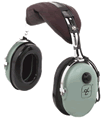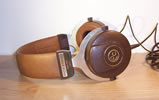The Mighty Headphone Quest Part 2
http://www.auditory.org/mhonarc/2004/msg00847.html
where headphones must be completely non magnetic and are optimised to be used to mask the noise and provide music to humans while getting an MRI scan. So like with so many things in life, it is about finding and using the right tool for the job. The primary focus of this evaluation to locate headphones that are optimised to act as a quality reference point for live sound engineers. So my plan is:
#1 - Listen wit my ears. I have big pile of cans and I am listening to music and switching between the various pairs while taking some notes of things I notice. Meanwhile I keep referring back the Sony CD3000's to keep my bearings straight.
#2 - Sort them by ear. I am sorting the headphones based on how close they sound to the reference pair..
#3 - Check credibility with test gear. Then I will try and figure out a way to measure the headphone using and see if what I heard and sorted has correlations with what I measure.
#4 Summarize. I will hopefully have a recommendation for one or more pairs.
So far there I am dealing with steps #1 and #2 and just begriming to plan out step #3. What I am finding is really interesting. The sound of headphones varies so vastly that it is truly incredible that they can even be listed with remotely similar specifications as there is almost no similarity in the way they sound.
As I listen I am sorting into some categories
A) DJ Sound. These all have some sort of big bass boost going on for listeners and DJ's that seek lots of extra low end.
B) Sloping Response. The lows are louder with a gradual slope downward towards the highs. This is actually a very listenable and common response and I like to tune sound systems this way. For example, with the EAW MicroWedge's, the Grey and Red processor settings are sloping responses.
C) Flat Sound. This is what I consider the CD3000's to exhibit though I have yet to test them on an analyzer. By comparison the sound is a bit bright but not lacking in low end. This would be the equivalent of the MicroWedge 'White' processor setting.
**** The Goal ****
The goal of this quest is to find the optimum live sound reference headphone. A portable accurate head worn sound system to act as a constant reference point. More specifically, a headphone that sounds as flat as possible.
Having a perfectly flat audible reference point allows the sound engineer to make informed auditory decisions by comparative reference. Additionally it reduces dependence on test equipment. By using comparative reference you can factor out the natural hearing fluctuations caused by plane flights, illness, age or long term exposure to high volume sound. Studio engineers have finely tuned and calibrated studio monitors in an optimum acoustic environment as a reference point, for us live engineers, a pair of headphones is our best bet.
Ideally you should be able to put on the headphones, listen to a CD, take them off, turn the CD up in the sound system and equalize the sound system to sound exactly like the headphones, therefore the sound system would be equalized to flat. I.E. - copy the sound of the headphones to the PA and have the CD sound as close as possible to the way it sounded in the recording studio.
Same thing with pink noise. Ideally you should be able to listen to pink noise in the headphones, take them off, listen to pink noise in the sound system, EQ the sound system by ear to sound like the headphones and the system should be flat. Then you ideally should be able to use an RTA or other measurement device, measure the pink noise coming from the sound system and confirm the system is truly eq'ed flat.
So that means that any aberration from flat the headphones exhibit will result in system EQ errors. For example: If you use headphones with extra bass, then the CD or pink noise in the headphones would sound low-end heavy. You would then be inspired to add extra low end to the sound system when matching the headphone sound to the PA sound. The low end heavy PA EQ would now cause several issues. When you EQ your mic channels you will tend to cut low end to compensate for the bass heavy PA. Any stereo recordings pulled pre system EQ will now be overly bright sounding. Imagine if recording studio monitors had a huge bass boost. Every recording coming out of that place would be super thin sounding. The goal is to have the console mix be flat before entering the system EQ's.
Note:
The console channel EQ's should make the mic/instrument combo sound correct.
The house system EQ should make the system/venue combo sound correct.
The system processor EQ should make the loudspeaker/enclosure combo sound correct.
Hence we seek a highly specific headphone. Flat flat and flat. Loud is good, wide response is good,low end is good, isolation is good, but first and foremost, flat. There are many amazing headphones out there that have numerous very desirable assets and people that swear by them. I have already begun testing and I am already finding that many of the popular live headphones are not ideal reference points. And also, at least one set of popular headphones make a quite good reference point.
So lets get some of the easier stuff out of the way and thin the herd a bit by starting with some I was considering that are marketed as DJ headphones:
Say Bye Bye to potential contenders:
Stanton DJ Pro-3000 - 50mm, 30 ohms, 106 db/mw, 20-20K
Pioneer HDJ-2000 - $349 List, $250 Street, 50mm, 36 ohms, 107 db/mw, 3500mw, 5-30K
But do not be sad as I am adding some that have been recommended to the list as well:
And due to requests, research and stuff laying around my house, say hello to:
Sennheiser HD 25-1 II - Yes they are 'over the ear' but popularity with sound engineers and numerous requests have inspired me to include them.
Denon AH-D2000 - Another requested headphone and with the over the ear design and large drivers it seemed worth testing
Pickering OA-3 - These are 1975 era open ear phones that I had laying around the house. I will toss them in the test mix just to give an idea of what people used to consider listenable. Oh, you really should check out the Pickering link I used and browse around.
Apple iPod ear buds - These are the standard ear buds that come with iPods. I figure that since these are most likely the most listened to things out there, may as well include them as a reference as well,

Sony MDR-90 - (I think) - I can not read the model # as it has worn off but these are some over the ear headphones that were my favourites before I found the CD3000's. They sounded great and though the mount broke, I still have them so why not add them to the test? I will shoot a epic and maybe someone will recognize them.
Beyer DT770M - Demo requested and it looks like they are coming.
AKG 271 MKII - Demo on it's way.
Equation Audio RP-22X - These are bass boost versions of the RP-21. Though I am not looking for bass boost, I may as well listen as they were kind enough to send me demo's.
Allen & Heath XONE XD-53 - $249 List, $199 Street, 53mm drivers, 36 ohms, 105 db/mw (1K), 350 mw, 5-33K. Very cool. I guess the blog gets around and Allen & Heath are sending me a pair to evaluate.
Ultrasone - HFI-780 - A third pair of ultrasone's have been added.
And finally there are two more on the potential list now
Ultraphones - These are high isolation headphones with Sony 7506 drivers.

David Clark Model 10S-DC - Which are also high isolation headphones.

Lastly for today's installment I want to thank the people and manufacturers that are helping me make this happen. Thank you Daniella and John Karr from Rat for putting up with my endless requests for more product!
Thank you Darlene from Audio Technica for going out of your way to expedite the request.
Thank you to all at Sennheiser as you always take care of us Rats.
Thank you Cynthia, Haley and Phil for spending time chatting with me and arranging the Koss headphones. Oh, check out http://www.koss.com/koss/kossweb.nsf/kmuseum?openform
Thank you Brian and Randy for rocking together the Ultrasone cans.
Thank you Equation Sound for hooking me up.
Thank you Beyer and AKG for sending out the phones.
Thank you Shure for the 840 demo unit.
Some of these companies Rat does quite a bit of business with while others do not know me or Rat well but were gracious warm and more than happy to assist.
Oh and can I tell you how cool it is to be knee deep in a pile awesome headphones! I am so a kid in a candy store!
Dave Rat



Comments
Display comments as Linear | Threaded
Dave Unger on :
Greg Cameron on :
Dave Rat on :
joshua evans on :
Dave Rat on :
Bob Rice on :
Dirk on :
Dave Rat on :
JD on :
hollis on :